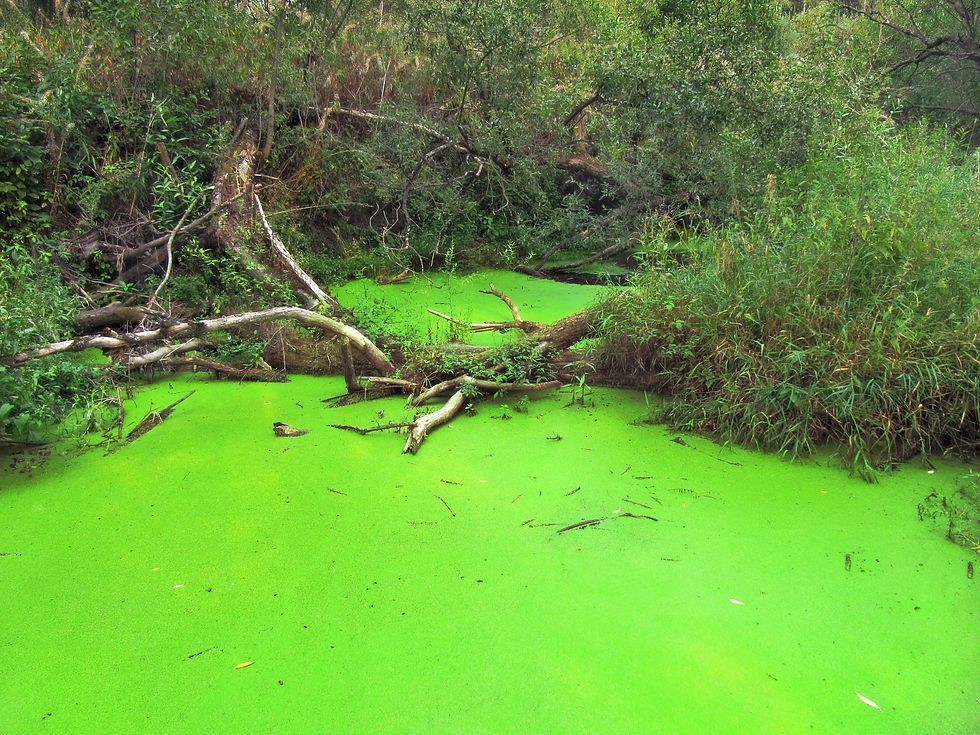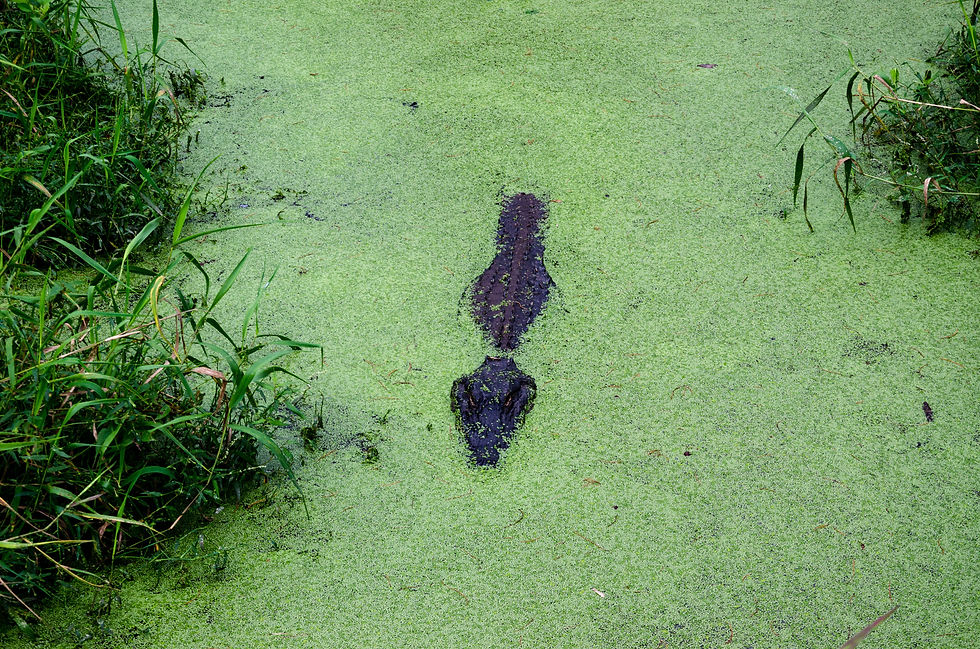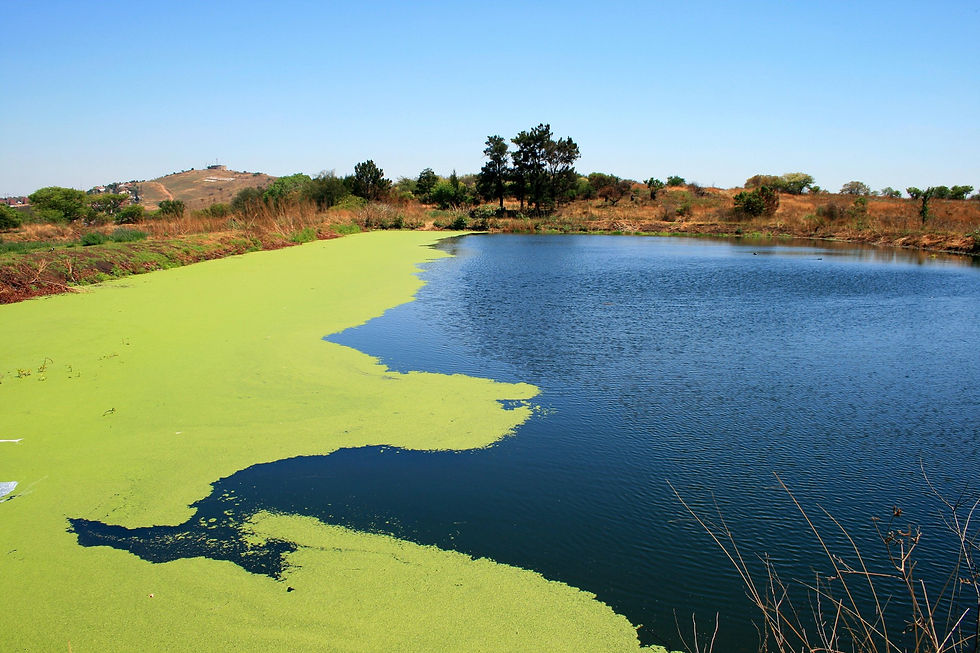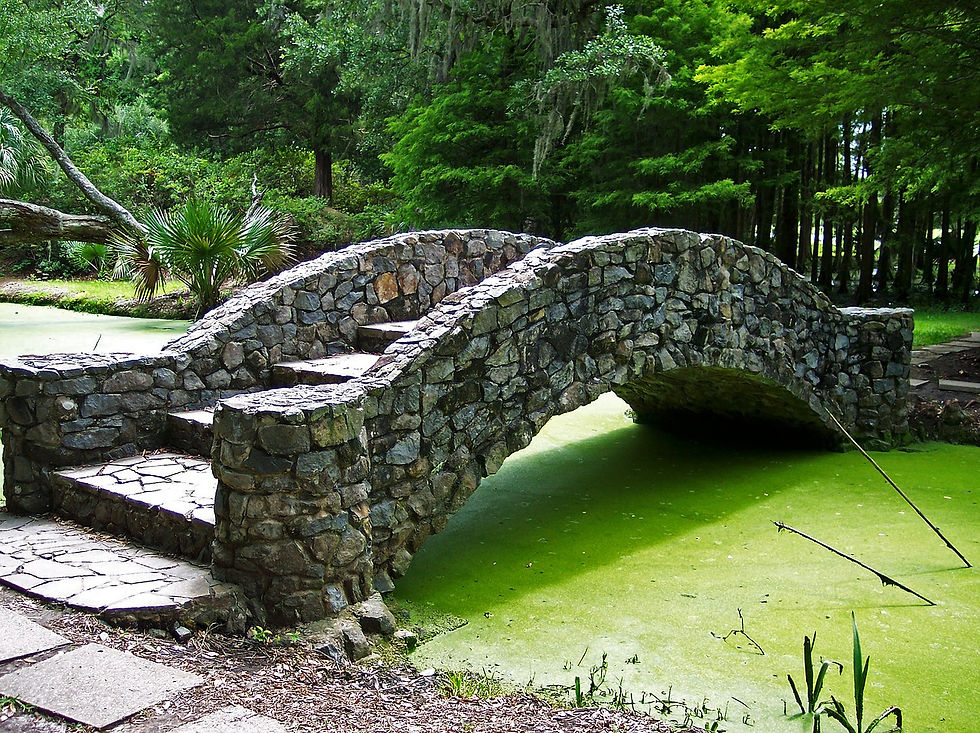Algal Blooms – What are they? Why should you care?
- Steve Booton
- 14 abr 2022
- 6 Min. de lectura

Algal or Algae bloom
A bloom is a rapid increase or accumulation in the population of algae in fresh or marine water systems and is often recognized by the discoloration in the water from their pigments such as red, blue-green and golden. The term algae encompass many types of aquatic photosynthetic organisms, both macroscopic, organisms like seaweed and microscopic, unicellular organisms like cyanobacteria. Algal bloom commonly refers to rapid growth of microscopic, unicellular algae that poses severe risk to aquatic, animal, and human life.
Algal blooms are the result of a nutrient, like nitrogen or phosphorus from fertilizer runoff, entering the aquatic system and causing excessive growth of algae. An algal bloom affects the whole ecosystem. Consequences range from the benign feeding of higher trophic levels to more harmful effects like blocking sunlight from reaching other organisms, causing a depletion of oxygen levels in the water, and, depending on the organism, secreting toxins into the water. The process of the oversupply of nutrients leading to algae growth and oxygen depletion is called eutrophication. Blooms that can injure animals or the ecology are called "harmful algal blooms" (HAB), and can lead to fish die-offs, cities cutting off water to residents, or states having to close fisheries.

HAB
Harmful algal blooms (HABs), sometimes known as "red tide", occur when certain kinds of algae grow very quickly, forming patches, or "blooms", in the water. These blooms can emit powerful toxins which endanger human and animal health. The severity of an outbreak can also cause significant losses to coastal economies that rely on recreation, tourism, and seafood harvesting.
An HAB contains organisms that can severely lower oxygen levels in natural waters. After the bloom dies, the microbes which decompose the dead algae use up even more of the oxygen, which can create further issues such as large quantities of dead fish known as “die off” or a “dead zone” where both fish and plants are destroyed.

What are the causes?
The presence of excessive nutrients in the water are a main cause of bloom formation. The two most common nutrients are nitrogen (nitrates, ammonia, urea) and phosphate. Overuse in agriculture, industry and domestic use are major contributors that can be related to flushing into the waterways or run off from heavy rain. According to many experts, there are links to climate change and the presence of warmer temperatures are playing a role in the size and frequency of formations.
Among the causes of algal blooms are:
· chemical wastes, primarily nutrients from fertilizers or human waste
· warmer temperatures
· thermal pollution from power plants and factories
· low water levels in inland waterways and lakes, which reduces water flow and increases water temperatures.

According to NOAA scientists, increased warmer weather can contribute to warmer waters which makes conditions more favourable for algae growth. Scientists in Australia have acknowledged that rising temperatures are also a key factor for algal blooms in the Southern hemisphere. However, in general, a reduction in water levels that can cause flows to drastically reduce or even stop lead to warmer conditions, combine that with excessive nutrients in the water increases the risk of harmful algal blooms.
These nutrients enter freshwater or marine environments caused by an overloading of fertilizer from agricultural pollution or urban runoff from fertilized lawns, golf courses and other landscaped properties, this is enhanced when heavy rain cannot penetrate and be absorbed by the soils. In the U.S., surface runoff is the largest source of nutrients added to rivers and lakes, but is mostly unregulated, locally developed initiatives to reduce nutrient pollution are underway in various areas of the country. Other significant causes include waste from sewage treatment plants that lack nutrient control systems, as an example in Southern Europe and coastal developing countries, the sewage is discharged into the sea untreated. Worldwide coastal areas, especially wetlands and estuaries, coral reefs, and swamps, are prone to being overloaded with those nutrients causing large ecological and environmental problems.

The effects can be devastating!
As algal blooms grow, they can last from a few days to many months depleting the oxygen in the water and blocking sunlight from reaching fish and plants. With a reduction in light, plants beneath the bloom can die and fish can starve. When the algae die off and decomposes, even more oxygen is consumed, which in turn causes more fish to die or not be present at all. When oxygen continues to be depleted this leads to dead zones or the term hypoxia, where neither fish nor plants can survive. This phenomenon occurs in aquatic environments as dissolved oxygen leading to a reduced concentration to a point where it becomes detrimental to aquatic organisms. An aquatic system lacking dissolved oxygen at (0%) is termed anaerobic or anoxic; the range between 1 and 30% is called hypoxic. Most fish cannot live below 30% saturation.

The negative impact on fish can be even more severe when bred in fish farms. A fish farm in British Columbia lost 260 tons of salmon and in 2016 a farm in Chile lost 23 million salmon after an algal bloom.
Generally, algae do not usually pose a direct threat to health, however, the toxins which they produce when ingested are considered dangerous to humans, land animals, sea mammals, birds, and fish. These neurotoxins can destroy nerve tissue which can affect the nervous system, brain, and liver, and ultimately lead to death. Tests have also shown that some toxins can be suspended in the air near beaches, it is important to understand that inhaling vapours from waves or wind during a bloom may cause asthma attacks or lead to other respiratory ailments, particularly those with allergies such as asthma.

Eating shellfish
Research has shown that algal toxins may be the cause for as many as 60,000 cases in the world each year when consuming fish or shellfish that have been sourced from water with the presence of a bloom. An accumulation of potent toxins in shellfish that feed on the algae and then later consumed by humans may result in various types of poisoning, the four most recognized are:
Amnesic,
Diarrhetic,
Neurotoxic
and Paralytic.
Environmental concerns
Harmful algal blooms are increasing throughout the world and it is suggested that global warming and excessive pollution are major contributors in their build up. Research has uncovered some dramatic findings on the presence of blooms in places thought it could not be possible such as the Arctic and Antarctic circles and to the mountains of the Himalayas and Rockies. More worrying is the growth of these HABs across some of the largest lakes on the planet across Europe, Africa, and Australia.

Chemical farming practices are one of the major contributors in the development of algae blooms. The demand for and overuse of fertilizers are much to blame on so many levels. Two main components of fertilizers are:
Organophosphorus compounds are used for their toxicity as pesticides, herbicides, insecticides, and fungicides.
Nitrogen
Negatively affects ground and surface waters, pollutes the atmosphere, and degrades soil health. When applied, not all the product is taken by the crop and is more than likely to be contained in run off due to its solubility. High doses leaching into waters contribute to groundwater pollution.

Fact not fiction
A recent forecast of the size of the "Dead Zone" in the northern Gulf of Mexico for late July 2019 is that it will cover 8,717-square-miles of the bottom of the continental shelf off Louisiana and Texas. The low oxygen conditions in the gulf's most productive waters stresses organisms and may even cause their death, threatening living resources, including fish, shrimp and crabs caught there. Low oxygen conditions started to appear 50 years ago when agricultural practices intensified in the Midwest. No reductions in the nitrate loading from the Mississippi River to the Gulf of Mexico have occurred in the last few decades. Source Louisiana State University

Current methods of control
A severe global challenge in controlling the spread of Cyanobacteria especially, for oceans, lakes, reservoirs, and larger ponds. Some control methods are not environmentally safe, for example, Algaecides. Other methods like aeration or ultrasound, are quite expensive.
Current algae control options that are commonly used include:
Chemicals
Aeration
Mixing
Ultrasound
The pro’s and con’s
Chemicals
There are not any Pro’s. Aquatic herbicides used to treat algae are called algaecides and pose significant threats yet are widely used, especially in areas near drinking water storage such as dams.

Mixing
Pro’s - Artificial circulation causes less environmental damage than using chemicals.
Con’s – Only effective in deep systems and can create further disturbance in the sediment that creates further nutrients to promote algal blooms.
Aeration
Oxygen helps break down the decaying vegetation and other nutrients in the water.
Pro’s - Aeration systems can help avoid chemical use and create a healthy ecosystem and can be used for large ponds.
Con’s - Aeration does not kill the algae directly, so it is not always efficient.
Ultrasound
Pro’s - Ultrasound is environmentally friendly and harmless to fish or plants.
Con’s - Must be able to cover the entire surface of a lake and is very cost prohibitive.
Not one of the above methods can effectively rid blooms without adding significant cost or chemicals in the process and are only designed for ground waterways. Our oceans are just as if not more important with no real solution.

ALGAL BLOOM SOLUTION
CUSTOM E ALGAE has been specially formulated utilizing the latest in biotechnology to eradicate HABs from ALL our waterways without the need for harsh and harmful chemicals. No longer does our ecosystem have to suffer from excessive pollution that causes our water to become toxic and dangerous.
Example of lab test results show the effectiveness on algae degradation.


by Steve Booton
Subscribe to our website to find out more www.customenzymes.com




Comments